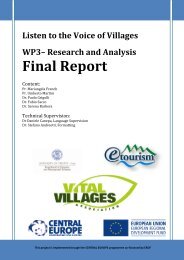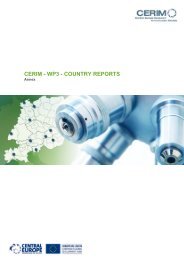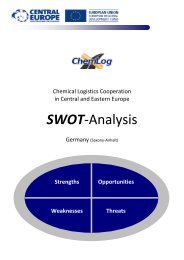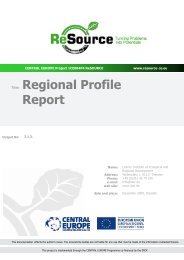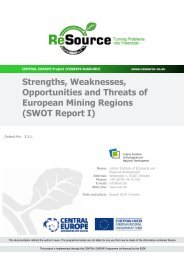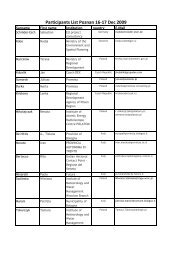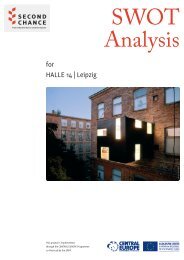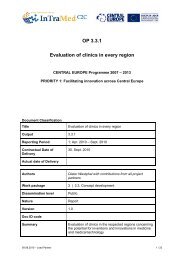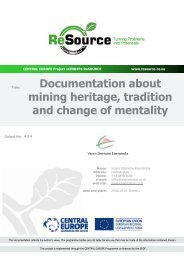Mainly on the Elbe River - Central Europe
Mainly on the Elbe River - Central Europe
Mainly on the Elbe River - Central Europe
You also want an ePaper? Increase the reach of your titles
YUMPU automatically turns print PDFs into web optimized ePapers that Google loves.
3 COMPARATIVE ECONOMIC CONDITIONS FOR TRANSPORT MODE<br />
SELECTION<br />
The issue of comparative ec<strong>on</strong>omic c<strong>on</strong>diti<strong>on</strong>s for <strong>the</strong> selecti<strong>on</strong> of a transportati<strong>on</strong> mode is<br />
ra<strong>the</strong>r complicated. The selecti<strong>on</strong> differs according to:<br />
• <strong>the</strong> type of transported commodities,<br />
• <strong>the</strong> amount of transported goods (suitable for cargo vessel or <strong>the</strong> whole train, etc.),<br />
• <strong>the</strong> requirements of <strong>the</strong> final customer (e.g. shipments for <strong>the</strong> producti<strong>on</strong> mode “just in<br />
time“),<br />
• o<strong>the</strong>r specific parameters.<br />
It may seem that some of <strong>the</strong> required transport parameters are not of ec<strong>on</strong>omic nature.<br />
Generally, substituti<strong>on</strong> for a selected transport mode is always possible with <strong>the</strong> corresp<strong>on</strong>ding<br />
c<strong>on</strong>sequences, such as increased costs for ei<strong>the</strong>r originator or recipient, or both. Therefore, it is<br />
necessary to assess <strong>the</strong> transportati<strong>on</strong> costs in a complex way.<br />
3.1 COMPARISON OF COSTS FOR A TRIP REALISED BY ROAD, RAILWAY AND<br />
INLAND WATER TRANSPORT<br />
The system of charging individual trips realised by different transport modes is various. In case<br />
of road and water transport, <strong>the</strong> difference in costs is not fundamentally different within EU member<br />
countries. For road transport, <strong>the</strong>re are two basic types of charging distinguished (performance fee<br />
or time fee). For nati<strong>on</strong>al waterway transport, charges are applied <strong>on</strong>ly <strong>on</strong> selected artificially<br />
c<strong>on</strong>structed secti<strong>on</strong>s of waterways. For railway transport, charges differ in each country.<br />
It is necessary to emphasize <strong>the</strong> fur<strong>the</strong>r development of future pricing of trips. The intenti<strong>on</strong><br />
of <strong>the</strong> EU is to charge road and railway transportati<strong>on</strong> according to <strong>the</strong> impact <strong>on</strong> <strong>the</strong> envir<strong>on</strong>ment.<br />
There is a rising tendency in increasing road-tolls and railway fees. This fact may bring ano<strong>the</strong>r<br />
comparative advantages to <strong>the</strong> waterway transport.<br />
In <strong>the</strong> following chapters, <strong>the</strong> basic system of charging different transport modes is presented<br />
for relevant countries. To enable comparis<strong>on</strong>, charges are c<strong>on</strong>verted to EUR as a comm<strong>on</strong><br />
currency. The following c<strong>on</strong>versi<strong>on</strong> rates were used: 1 EUR = 25,5 CZK and 1 EUR = 4,12 PLN.<br />
A feasibility study for “Improvement of C<strong>on</strong>diti<strong>on</strong>s for <strong>the</strong> <strong>River</strong> Transport in <strong>Central</strong> <strong>Europe</strong> (mainly <strong>on</strong> <strong>the</strong> <strong>Elbe</strong><br />
<strong>River</strong>)“ realized within <strong>the</strong> ChemLog project 119




